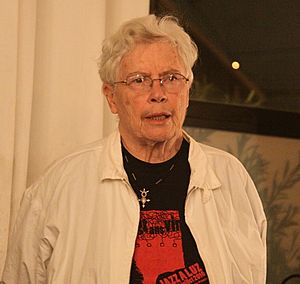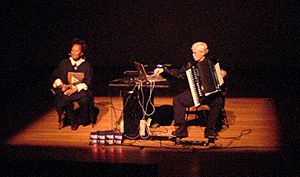Pauline Oliveros facts for kids
Quick facts for kids
Pauline Oliveros
|
|
|---|---|

Pauline Oliveros in Oakland, 2010
|
|
| Born | May 30, 1932 Houston, Texas, U.S.
|
| Died | November 24, 2016 (aged 84) Kingston, New York, U.S.
|
| Occupation | Musician |
| Known for | Deep Listening Band |
| Spouse(s) | Carole Ione Lewis |
Pauline Oliveros (born May 30, 1932 – died November 24, 2016) was an American composer and accordion player. She was very important in creating new kinds of experimental and electronic music after World War II.
She helped start the San Francisco Tape Music Center in the 1960s and was its director. She also taught music at several universities, like Mills College and the University of California, San Diego (UCSD). Pauline Oliveros wrote books and created new ideas about music, such as "deep listening" and "sonic awareness." These ideas helped people pay closer attention to sounds.
Contents
Early Life and Music Journey
Pauline Oliveros was born in Houston, Texas. She started playing music when she was very young, in kindergarten. At nine years old, she began to play the accordion. Her mother, who was a pianist, gave it to her because it was a popular instrument in the 1940s. Later, she learned to play the violin, piano, tuba, and French horn for school and college music classes. When she was sixteen, she decided she wanted to become a composer.
Oliveros moved to California and worked a day job to support herself. She also taught accordion lessons to earn extra money. She then went to the Moores School of Music at the University of Houston. She studied with Willard A. Palmer there. She earned a special degree in composition from San Francisco State College. Her teachers included the composer Robert Erickson, who taught her privately for many years. This is also where she met other artists like Terry Riley, Stuart Dempster, and Loren Rush.
When Oliveros turned 21, she got her first tape recorder. This led her to create her own music pieces and future projects using tape. Oliveros was one of the first members of the San Francisco Tape Music Center. This center was a very important place for electronic music on the U.S. West Coast in the 1960s. The Center later moved to Mills College, and Oliveros became its first director. It was then renamed the Center for Contemporary Music. Oliveros often used her own electronic system, called the Expanded Instrument System, to create music during her performances and recordings. She received special honorary doctorates in music from several universities.
Time at UCSD
In 1967, Oliveros left Mills College to become a music professor at the University of California, San Diego (UCSD). While there, Oliveros met Lester Ingber, a scientist and karate master. They worked together to understand how people pay attention when listening to music. She also studied karate with Ingber and earned a black belt. In 1973, Oliveros did studies at the University's Center for Music Experiment. She was the director of this center from 1976 to 1979. In 1981, she left her job at UCSD to have more creative freedom. She moved to upstate New York to work as an independent composer, performer, and advisor.
Deep Listening Concept
In 1988, Pauline Oliveros went 14 feet underground into a large water tank called the Dan Harpole cistern. She went there to make a special recording. After this experience, she created the term "deep listening." This idea became a way of thinking about music. It is based on using improvisation, electronic music, rituals, teaching, and meditation. This way of listening helps both trained and untrained musicians practice paying close attention to sounds around them. They learn to respond to these sounds alone or with a group.
Stuart Dempster, Oliveros, and Panaiotis then formed the Deep Listening Band. "Deep listening" also became a program of the Pauline Oliveros Foundation, which she started in 1985. The Deep Listening program includes yearly listening retreats in different places, as well as training programs. The Pauline Oliveros Foundation later changed its name to Deep Listening Institute, Ltd.
The Deep Listening Band, which included Oliveros, David Gamper, and Stuart Dempster, often performed and recorded in places with strong echoes. These places included caves, cathedrals, and huge underground water tanks. They worked with other artists like Ellen Fullman and her long-string instrument. The Center for Deep Listening at Rensselaer (CDL@RPI) now continues the work of the Deep Listening Institute.
Sonic Awareness Theory
Heidi Von Gunden wrote about a new music theory that Oliveros developed, called "sonic awareness." This theory is about being able to consciously focus your attention on sounds from your environment and from music. It means you need to be always alert and willing to listen. Von Gunden says it's like how John Berger described seeing things in his book Ways of Seeing.
Oliveros talked about this theory in her Sonic Meditations and in other articles. Von Gunden explains that sonic awareness combines ideas from the psychology of how we think, the physical training of martial arts, and the ideas of the feminist movement. She describes two ways we process information: "attention" and "awareness." These are also called focal attention (like a dot) and global attention (like a circle). Oliveros often used these symbols in her music, like Rose Moon (1977) and El Rilicario de los Animales (1979).
Later, this idea was expanded. The circle was divided into four parts, representing:
- Actively making sound
- Imagining sound
- Listening to present sound
- Remembering past sound
This model was used in Sonic Meditations. Practicing this theory helps create rich and full sounds that have a strong central musical note.
Other Achievements
Oliveros taught at Rensselaer Polytechnic Institute and Mills College. She was born in Houston, Texas, in 1932, and passed away in 2016 in Kingston, New York.
While attending the University of Houston, she was part of the band program. She also helped start the Tau chapter of Tau Beta Sigma Honorary Band Sorority.
Pauline Oliveros received several awards for her work. In 1994, she got a Grants to Artists award from the Foundation for Contemporary Arts. In 2007, she received the Resounding Vision Award from Nameless Sound. She also received the William Schuman Award from Columbia University School of the Arts in 2009. In 2012, she was given the John Cage Award from the Foundation for Contemporary Arts.
Oliveros wrote five books about music and listening:
- Sounding the Margins: Collected Writings 1992–2009
- Initiation Dream
- Software for People
- The Roots of the Moment
- Deep Listening: A Composer's Sound Practice
Some of her music was used in the French video game NaissanceE in 2014. Her work called Deep Listening Room was shown at the 2014 Whitney Biennial, which is a big art exhibition.
Oliveros was also a member of the Avatar Orchestra Metaverse. This was a group of composers, artists, and musicians from all over the world. They used the virtual reality platform Second Life as a musical instrument itself. She was also a supporter of Soundart Radio in Dartington, Devon.
Notable Works
- Sonic Meditations: This collection includes pieces like "Teach Yourself to Fly."
- Sound Patterns for mixed chorus (1961): This piece won the Gaudeamus International Composers Award in 1962. You can find it on albums like Extended Voices and 20th Century Choral Music.
- I of IV (1967): This electronic music piece was included in the collection New Sounds in Electronic Music.
- Theater of Substitution series (1975–?): In this series, Oliveros dressed up as different characters, like a Spanish lady or a professor. Other artists also played her in performances.
- Crone Music (1989)
- Six for New Time (1999): This was a music score she created for the band Sonic Youth.
- "the Space Between with Matthew Sperry" (2003)
Films About Pauline Oliveros
- 1976 – Music with Roots in the Aether: Opera for Television. This film focused on Pauline Oliveros. It was produced and directed by Robert Ashley.
- 1993 – The Sensual Nature of Sound: 4 Composers – Laurie Anderson, Tania León, Meredith Monk, Pauline Oliveros. This film was directed by Michael Blackwood.
- 2001 – Roulette TV: Pauline Oliveros.
- 2005 – Unyazi of the Bushveld. This film was directed by Aryan Kaganof.
See also
 In Spanish: Pauline Oliveros para niños
In Spanish: Pauline Oliveros para niños



